Petrographic and geochemical characterization of weathered materials developed on BIF from the Mamelles iron ore deposit in the Nyong unit,South-West Cameroon
Tessontsap Teutsong·Jean Pierre Temga·Armelle Ayissi Enyegue·Nicodème Noel Feuwo,2·DieudonnéBitom,3
Abstract Iron ore deposits hosted by Precambrian banded iron formation(BIF)are the most important source of mineable iron.In Cameroon,they are located in the southern part of the country.This study reports the petrological and geochemical data of iron ores collected from a weathering profile in the Mamelles BIF deposit,SW Cameroon.The profile is composed of three levels which are from the bottom to the top:the saprock,the ferruginous horizon,and the loose horizon.Eight representative iron ore samples(rock fragments and loose clayey material)were collected along the profile and were subjected to petrographic and geochemical analyses.Their mineralogy consists of martite,goethite,quartz,and lesser amounts of hematite,magnetite,kaolinite,and halloysite.The presence of minerals such as kaolinite and goethite in the Mamelles iron ores suggests their supergene origin.Geochemically,the saprock is characterized by high iron content(70.25 wt%Fe2O3t),and low silica(26.38 wt%SiO2)and alumina(1.14 wt% Al2O3).The rock fragments collected from the ferruginous horizon display higher Fe2O3t(72-76.40 wt%),Al2O3(2.80-5.43 wt%),and lower SiO2(16.70-18.35 wt%)contents,suggesting the leaching of silica during the enrichment process.The loose clayey samples collected from both the ferruginous horizon and the upper loose horizon show lower iron and higher silica contents.When normalized to the underlying BIF saprock,both rock fragments and loose clayey ores display LREE enrichment,suggesting that they formed through supergene processes.Economically,most of the Mamelles iron ores are classified as medium-grade ores and a few display acceptable contents in contaminants.Overall,this petrological and geochemical study of the Mamelles iron ores revealed encouraging results.Given its strategic location near the deep seaport,the deposit should be investigated in more detail for its mining potential.
Keywords Mamelles BIF·Medium-grade iron ore·Supergene origin·Nyong unit·Cameroon
1 Introduction
Banded iron formations(BIFs)are chemical marine sediments,thinly bedded or laminated,comprising alternating layers of iron-rich minerals and chert,and containing at least 15%of iron of sedimentary origin(James 1954).BIFs deposited between ca.3.8 and ca.1.8 Ga,with the exception of a few between 0.8 and 0.6 Ga(Klein 2005).The peak in BIF formation between 2.7 and 2.3 Ga appears to correlate with major changes in Earth’s history such as the rise of atmospheric oxygen and the change from anoxic to oxic conditions in the ocean(Holland 2006).Based on their iron mineralogy,James(1954)defined four facies,namely oxide-facies(including magnetite and hematite subfacies),silicate-,carbonate-and sulfide-facies,among which,the oxide-facies is the most important.Based on their depositional environment and types of associated rocks,Gross(1980)subdivided them into Superior and Algoma types.Superior-type BIFs were deposited in nearshore continental-shelf environments and are associated with carbonates,quartzites,and black shales.Algoma-type BIFs are consistently associated with volcaniclastic rocks and were deposited in arc or rift settings.
Iron ore has been mined from igneous,metamorphic,and sedimentary hosted deposits.Banded iron formationshosted iron ore deposits are the major source of high-grade iron ore both in quantity and quality compared to other sources(Beukes et al.2002;Dalstra and Rosière 2008).BIF-hosted iron ores have been well reviewed by several researchers(e.g.,Clout and Simonson 2005;Ramanaidou and Wells 2014;Hagemann et al.2016).Currently widely accepted genetic models for BIF-related iron ores include supergene,hypogene,and supergene-modified hydrothermal deposits(Beukes et al.2002).Supergene models interpret the ores to be residual concentrates formed from leaching of gangue in the iron formation by deep circulating groundwater(Morris 1993).The genesis of hypogene ores is ascribed to the interaction of the BIF protore with a hydrothermal fluid,which dissolved chert(or quartz),leaving pore spaces,which are filled by a new generation of iron oxides(Spier et al.2008).Supergenemodified hydrothermal ores have first formed through hydrothermal activity,and then at a later stage have undergone supergene enrichment(Beukes et al.2002).
A large number of BIFs in Cameroon are distributed in the Ntem complex,which is Archean to Paleoproterozoic in age(Pouclet et al.2007).BIF-hosted iron ores in the Ntem complex have been extensively investigated by both Exploration Mining Companies and researchers(Suh et al.2008;Ganno et al.2015,2016,2017,2018;Teutsong et al.2017;Ndime et al.2018;Soh Tamehe et al.2018,2019;Odigui et al.2019).Surprisingly,very limited data are available on the Mamelles deposit,one of the first discovered BIF-hosted iron ore deposit in South Cameroon.In this paper,we present petrographic and geochemical data of BIF-related iron ores from the Mamelles deposit intending to constrain their genesis.
2 Geological setting
The geological setting of SW Cameroon corresponds to the Ntem complex which defines the northwestern edge of the Congo craton in southern Cameroon(Maurizot et al.1986).This complex is bounded to the north by the YaoundéGroup which is part of the Pan-African orogenic belt in Central Africa(Nédélec et al.1986;Nzenti et al.1988).It has been subdivided into three units based on age and lithology namely:Ntem,Nyong,and Ayna.
The Nyong unit contains the Mamelles deposit(Fig.1)and was initially defined as a Paleoproterozoic to Neoproterozoic reactivated NW corner of the Archean Congo craton(Lasserre and Soba 1976;Feybesse et al.1986).It consists of:(1)metasediments and metavolcano-sediments which may correspond to remnants of greenstone belts;they include orthopyroxene gneisses,garnet amphibolopyroxenites and gneisses,banded iron formations,mafic and ultramafic metavolcanics;(2)syn-to late-tectonic charnockites,augen metadiorites,granites,and syenites;(3)migmatitic grey gneisses of TTG composition;(4)posttectonic metadolerites(Penaye et al.2004;Lerouge et al.2006).The Nyong unit is characterized by a regional flatlying composite S/Sfoliation with N-S to NNE-SSW axial fold lineations and E-W to NW-SE stretching lineations(Feybesse et al.1986;Toteu et al.1994).The metamorphic evolution is polycyclic with Paleoproterozoic granulitic assemblages overprinted in the western part of the Group by Pan-African high-grade recrystallizations(Toteu et al.1994).
The Mamelles deposit is located in SW Cameroon,about 20 km East of the Atlantic coast.It lies between latitudes 2°3017and 2°3641N and longitudes 9°5540and 9°5839E(Fig.2).The deposit stretches over 15 km and covers an area of 7 to 8 km.It occurs in a form of synclinorium associated with mafic rocks of the Nyong unit(Ntep Gweth et al.2003).Rocks found in the area are banded iron formations,amphibolites,pyroxenites,eclogites,and garnet gneisses.The region is subject to a south coastal equatorial climate(Suchel 1987).Precipitation is very high and averages 6500-7000 mm per year.Temperatures are relatively high,averaging between 25 and 28°C.The climate is characterized by alternating dry and wet periods,with the year beginning with a short dry season that lasts from December to February,followed by a heavy wet season from March to November.
3 Sampling and analytical procedures
The weathering profile investigated during this study is located at latitude 2°3527N and longitude 9°5730E(Fig.2).Eight samples were collected for mineralogical and geochemical analyses.Samples were jaw crushed and milled at the ALS Chemex preparation facility in Yaoundé(Cameroon).
Petrographic observations were undertaken using transmitted and reflected light microscopy on polished thin sections at ETH Zurich,Switzerland.X-ray diffraction(XRD)analysis was performed at the laboratory of‘Argiles,Géochimie et Environments sédimentaires(AGEs)’from the University of Liège(Belgium).XRD patterns were obtained from random powders(<250 μm in size)using a Bruker D8 Advance diffractometer,with CuKα radiation(λ=1.5418 A˚),operating at 40 kV and 25 mA.The diffraction patterns were recorded over the 3-70°2 theta range,in steps of 0.02°2 theta with a 0.5 s counting time per step.

Fig.1 Geological map of SW Cameroon.Modified after Pouclet et al.(2007)
At ALS Chemex laboratory(Loughrea,Ireland),samples were analyzed for major,trace,and rare earth elements.A prepared sample(0.2 g)was added to lithium metaborate/lithium tetraborate flux(0.9 g),mixed well,and fused in a furnace at 1000 °C.The resulting melt was then cooled and dissolved in 100 mL of 4% nitric acid/2%hydrochloric acid.This solution was then analyzed by ICPAES(Inductively Coupled Plasma-Atomic Emission Spectroscopy)for major elements and by ICP-MS(Inductively Coupled Plasma-Mass Spectroscopy)for trace and rare earth elements.The detection limit was 0.01%for major oxides,0.05 to 10 ppm for trace elements,and 0.01 to 0.05 ppm for rare earth elements.Loss on ignition(LOI)was also done at 1000 °C.
4 Petrography and mineralogy
4.1 Description of the weathering profile
The profile is~4 m thick and composed of three horizons which are from the bottom to the top:the saprock,the ferruginous horizon,and the loose horizon(Fig.3).The BIF saprock(sample KRI4)generally appears highly weathered and characterized by iron-rich bands alternating with silica-rich bands.The ferruginous horizon can be subdivided into two levels.The lower part is marked by the occurrence of numerous coarsely-rounded weathered rock fragments in a loose clayey matrix.The fragments(sample KRI3)account for about 80% volume of the material and have partially preserved the structure of the underlying BIF saprock(Fig.3).The matrix(sample KRId)is yellowish red(5YR 5/6)in the humid state,with sandy-clay texture.The transition to the upper level is marked by the reduction of the size of rock fragments.
The upper part of the ferruginous horizon consists of centimetric weathered rock fragments and platelets(sampleKRI2)embedded in a loose yellowish red(5YR 5/6),sandy-clay matrix(sample KRIc).The fragments are strongly indurated with angular contours and represent 30-50%volume of the material(Fig.3).Towards the top,rock fragments(samples KRI1 and KRIb)are scarce,smaller,and more dispersed while roots progressively appear.The transition to the superficial level is gradual and marked by the change of color and more pronounced biological activity.
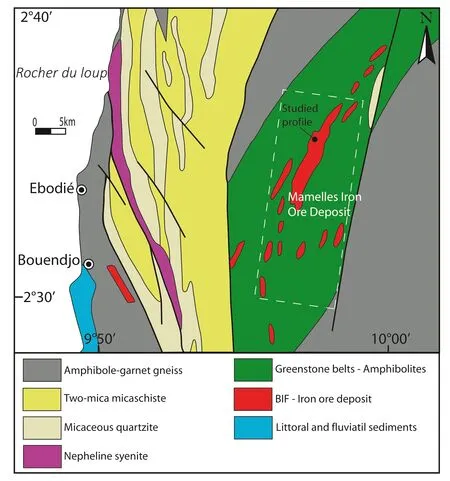
Fig.2 Geological map showing the location of the Mamelles iron ore deposit.Modified after Maurizot et al.(1986)
The loose horizon is dark brown(7.5YR 5/6)and corresponds to the organo-mineral horizon.It consists of a sandy-clay material(sample KRIa)with a lumpy structure.This horizon is also marked by traces of biological activity,expressed with abundant millimetric-to centimetric-sized roots,microflora,and microfauna(Fig.3).
4.2 Petrography and mineralogy of iron ores
Microscopic studies of the iron ore samples under reflected light microscope revealed that the present iron ore samples are mainly composed of martite,goethite,and quartz,with smaller amounts of magnetite and hematite(Fig.4).Martite,hematite,and quartz are in complete crystalline form.XRD analysis further identified hydrated aluminum clay minerals such as kaolinite and halloysite(Figs.5,6).
Martite is identified under the microscope by the typical scaffold-like intergrowth of hematite lamellae that replace magnetite along the planes of octahedra{111}.The martite,which is a pseudomorph of magnetite,in most cases,retains the shape of precursor magnetite(Fig.4a).Martite occurs as subhedral to euhedral,up to 0.5 mm in size crystals,showing straight to smoothly curved grain boundaries.Figure 4b shows martitization with relict magnetite grains.In some places,another generation of hematite(white)appears to form after martite(Fig.4c).Onthe X-ray diffractogram,hematite can be easily indexed from its sharp reflection peaks at 2.69 A˚(I=100),1.69 A˚(I=45)and 3.67 A˚(I=35)whilst magnetite exhibits peaks at 2.52 A˚(100),2.97 A˚(30)and 1.71 A˚(15)(Figs.5,6).
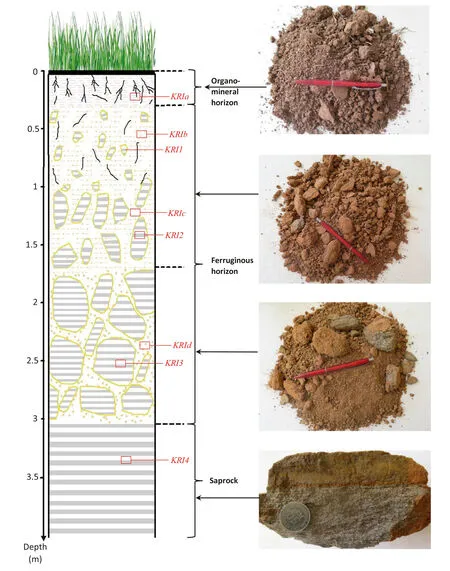
Fig.3 Weathering profile with sample location
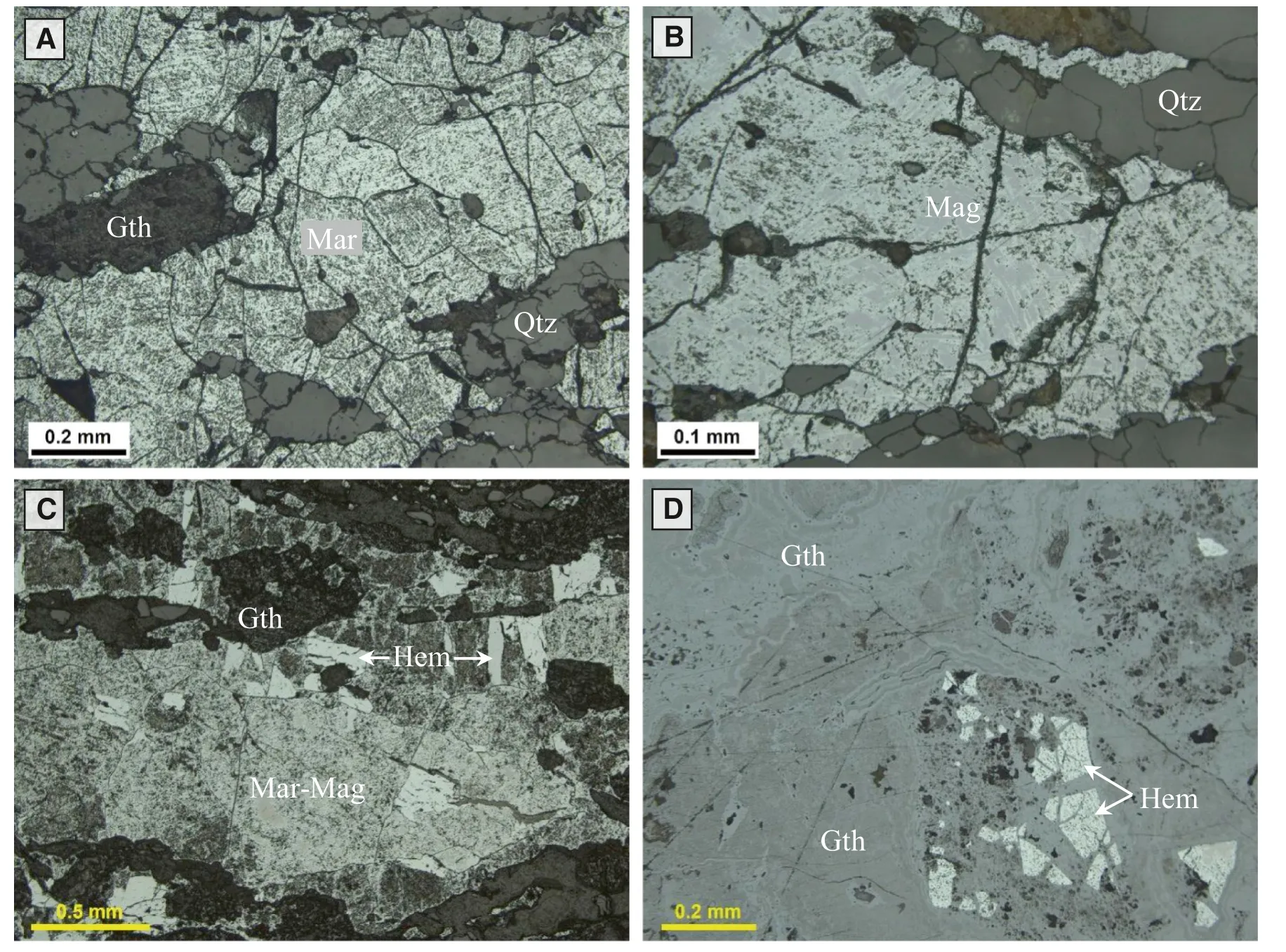
Fig.4 Photomicrographs illustrating the petrography of iron ores from the Mamelles deposit.a Martite grains associated with goethite.b Martitization with relicts of magnetite.c Iron ore showing martite-magnetite-hematite-goethite association.d Hematite grains within colloform goethite.Mineral abbreviations according to Whitney and Evans(2010)
Apart from martite,the other major iron-bearing phase is goethite.Goethite occurs as selective replacement around the martite grains as well as in localized spots or blotches.Goethite can also occur as colloform bands(Fig.4d)and vein filling within the voids and cavities(Fig.4a-c)which results due to the leaching out of preexisting minerals.The cavities are mostly developed along the weaker planes in between the mineral bands.Some patches of hematite are also found within the goethite matrix as observed in Fig.4d.The main XRD peaks of goethite appeared at 4.18 A˚(I=100)and 2.45 A˚(I=25)(Figs.5,6).
XRD analysis revealed that weathered materials from the Mamelles BIF contain Al-rich clay phases such as kaolinite and halloysite that were not identified with the microscope.They show very weak peaks at about 7.20 A˚(I=100)and 3.57 A˚(Figs.5,6).Quartz was identified by its characteristic peaks at 3.34 A˚(I=100),4.26 A˚(I=35)and 1.81 A˚(I=17)(Figs.5,6).Under the microscope,it occurs as up to~0.4 mm large,anhedral to subhedral,grains showing a shape preferred orientation in places(Fig.4a,b).
5 Geochemistry
5.1 Major elements
Major and trace element concentrations of iron formations from the Mamelles deposit are shown in Table 1.The saprock consists essentially of iron(70.25 wt%FeO)and silica(26.38 wt% SiO).Alumina and phosphorous contents are relatively low,1.14 wt% AlOand 0.25 wt%PO.The other oxides are consistently close to,or below the detection limit.
In the rock fragments from the ferruginous horizon,major oxide components are FeO,SiOand AlO,ranging 72-76.40 wt%,16.70-18.35 wt% and 2.80-5.43 wt%,respectively(Table 1).TiOvaries from 0.14 to 0.18 wt% and POfrom 0.13 to 0.34 wt%.The remaining oxides display contents close to the detection limit.

Fig.5 X-ray diffraction patterns of saprock and rock fragments
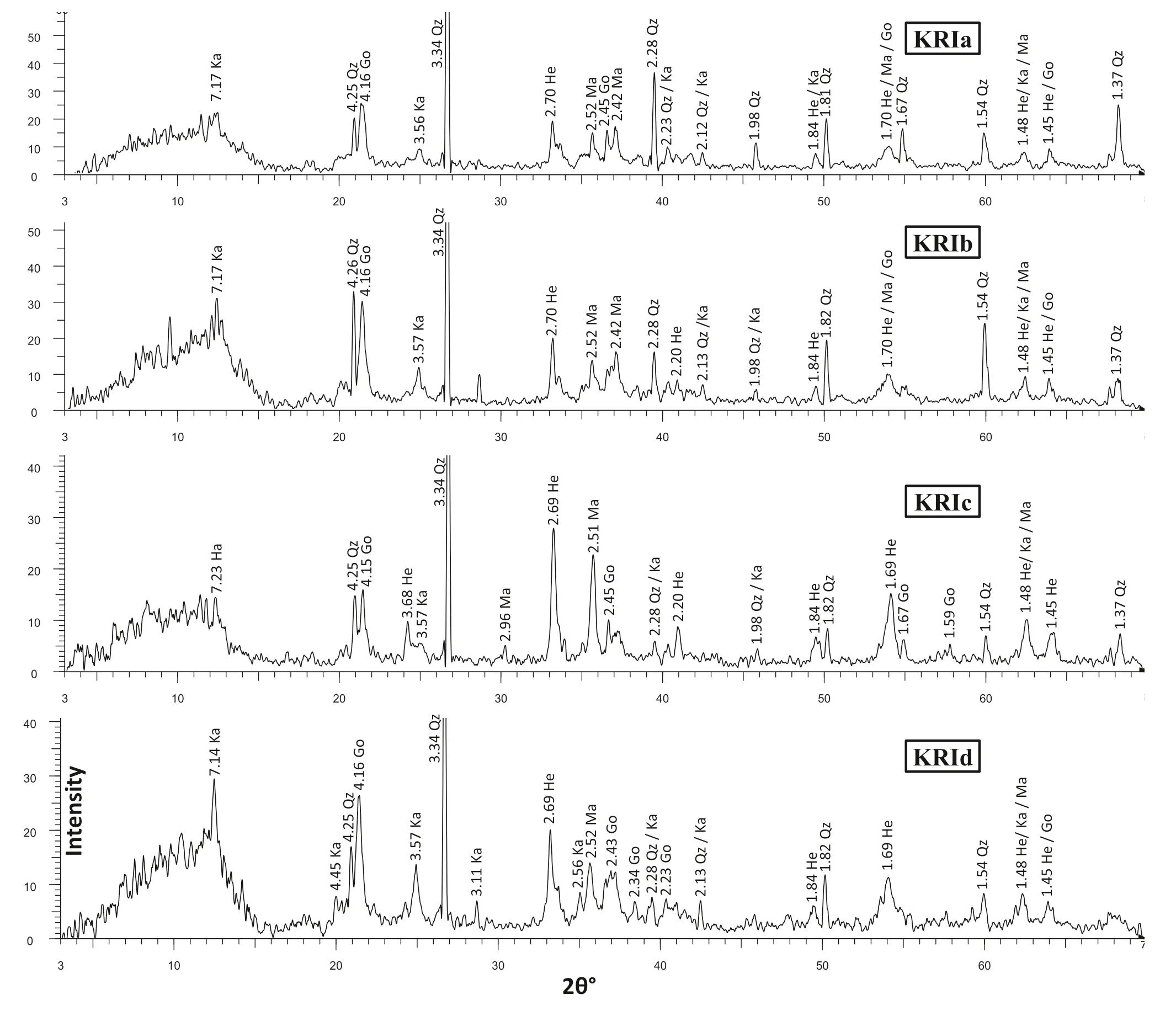
Fig.6 X-ray diffraction patterns of loose clayey material
5.2 Trace elements
Transition elements(V and Cr)record the highest concentrations in the saprock with values of 16 ppm and 210 ppm,respectively.Cr is relatively constant in the rock fragments with an average of 213.33 ppm.Vanadium also displays significant enrichment in rock fragments ranging from 30 to 46 ppm(Table 1).
Large ion lithophile elements(LILE)in this study are represented by Rb,Sr,and Ba.All of them show low concentrations in the saprock but are substantially enriched towards the surface.Indeed,Rb,Sr,and Ba in the saprock are 0.3 ppm,1.0 ppm,and 3.9 ppm,respectively(Table 1).In the rock fragments,Rb varies from 0.4 to 3.3 ppm,Sr from 2.8 to 6.2 ppm,and Ba from 9.3 to 33.2 ppm.
Among the high field strength elements(HFSE),Zr displays the highest values:11 ppm in the saprock to up to 120 ppm in the loose horizon at the surface(Table 1).Significant concentrations are recorded for some elements such as Y,Nb,and Th,while the other HFSE namely Hf and U are relatively low(<3.5 ppm).
5.3 Rare earth elements
Rare earth element(REE)data are listed in Table 1 together with the major and other trace element contents.The total REE content is low in the saprock(ΣREE=6.96ppm).In the rock fragments,ΣREE concentrations are higher,ranging from 15.79 to 34.15 ppm.Post Archean Australian Shale(PAAS,Taylor and McLennan 1985)normalized REE and yttrium(REY)pattern of the saprock displays LREE depletion relative to HREE(La/Yb~0.17),strong positive europium anomaly(Eu/Eu=2.9)and slightly positive Y anomaly(Fig.7),typical of BIFs worldwide.This implies that the saprock has preserved the original geochemical signature of the primary BIF from the Mamelles deposit.This pattern also shows that the Mamelles BIF displays a more pronounced Eu anomaly compared to other BIFs from the Nyong unit.When normalized to the BIF saprock(sample KRI4),both rock fragments and loose clayey samples display LREE enrichment and negative Eu anomalies(Fig.8).
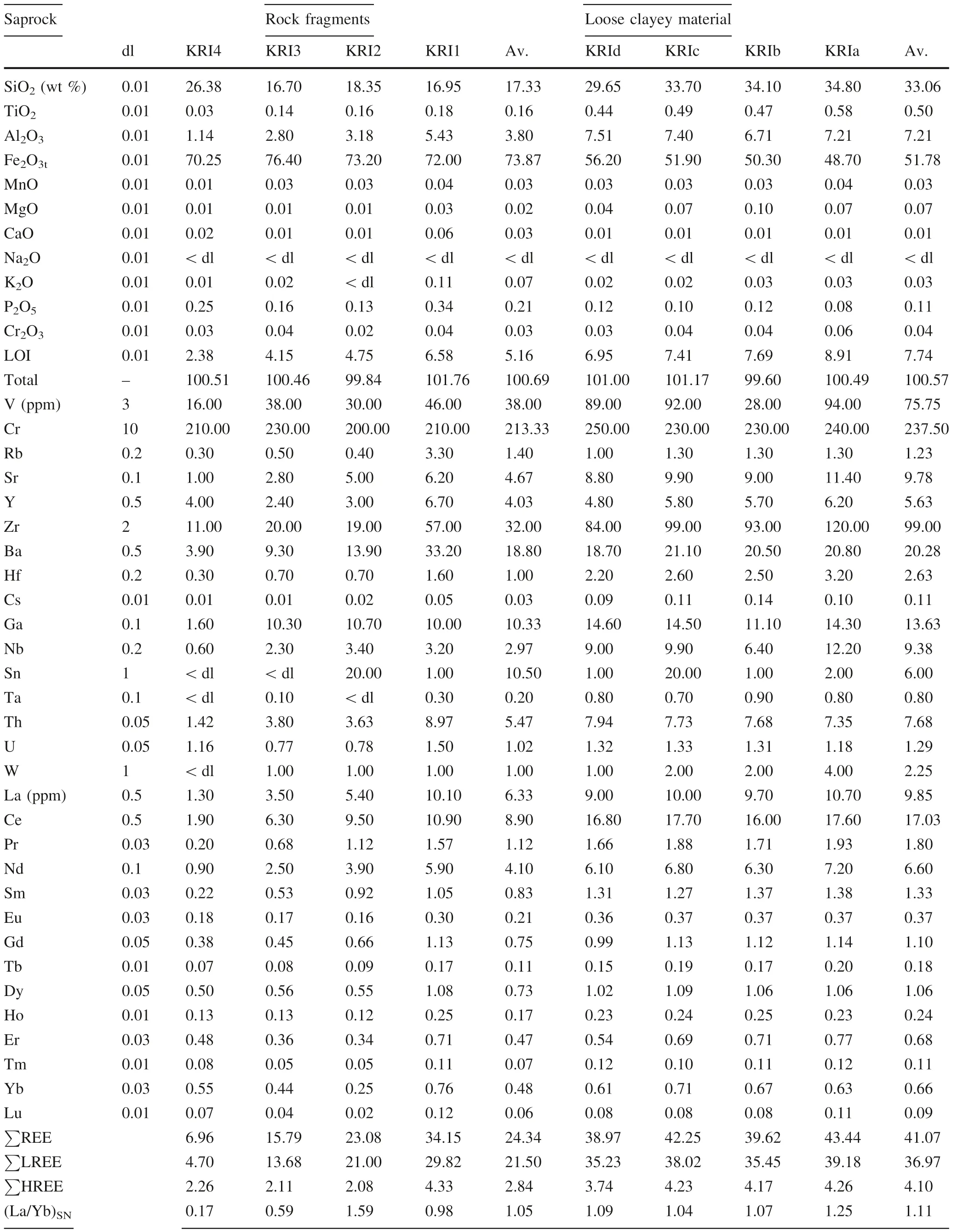
Table 1 Major(wt%)and trace(ppm)element contents in the Mamelles iron ores

Table 1 continued
6 Discussion
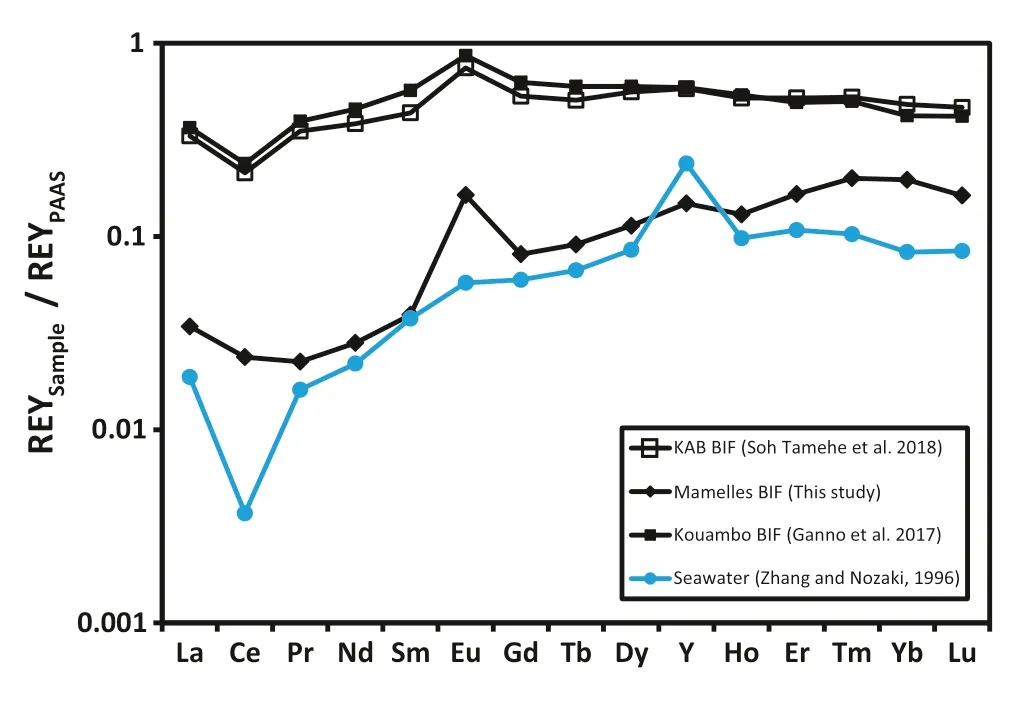
Fig.7 Post Archean Australian Shale(PAAS;Taylor and McLennan 1985)normalized rare earth element and yttrium(REY)patterns of the Mamelles BIF saprock and other BIFs from the Paleoproterozoic Nyong unit.Kouambo BIF:average composition from Ganno et al.(2017).KAB(Kpwa-Atog Boga)BIF:average composition from Soh Tamehe et al.(2018).Seawater data:average of 0,9 and 30 m depth samples of station SA-5(Zhang and Nozaki 1996)
The commercial exploitation of iron ores is mainly determined by its chemical composition.It is generally accepted that high-grade iron ores are characterized by total Fe(TFe)content above 60 wt%(Hagemann et al.2016),whereas medium-grade and low-grade iron ores show lower TFe ranges,depending on the authors and the deposits.Angerer et al.(2012)recently introduced a simple discrimination plot visualizing various iron ore grades,based on major oxide ratios SiO/FeOand(MgO+CaO+MnO)/FeO.The diagram shows that most of the Mamelles iron ores plot in the field of medium-grade ore and a few near the boundary between low-grade and medium-grade ores(Fig.9).
Beukes et al.(2002)proposed three genetic models for BIF-hosted iron ore deposits,namely supergene,hydrothermal,and supergene-modified hydrothermal deposits.In all these deposits,it should be pointed out that the main factor of enrichment is through either leaching of gangue minerals(chert,quartz,carbonates,silicates)from the BIF protore or replacement of silica by iron oxide minerals(hematite and/or magnetite)or a combination of both(Gutzmer et al.2008).In the study area,petrographic,mineralogical,and geochemical data combined with field observations indicate that iron ores formed through supergene processes.Supergene alteration from‘‘cold’’oxidizing meteoric waters,resulted in the replacement of magnetite by martite as shown in Fig.4.Martitization has been observed in several supergene iron ores(e.g.Gutzmer et al.2008;Lascelles and Tsiokos 2015).A supergene origin of iron ores from the Mamelles deposit is further supported by the presence of mineral phases such as kaolinite and goethite,typical of the supergene environment(Anand and Paine 2002).

Fig.8 REE patterns of the rock fragments and loose clayey material normalized to the BIF saprock
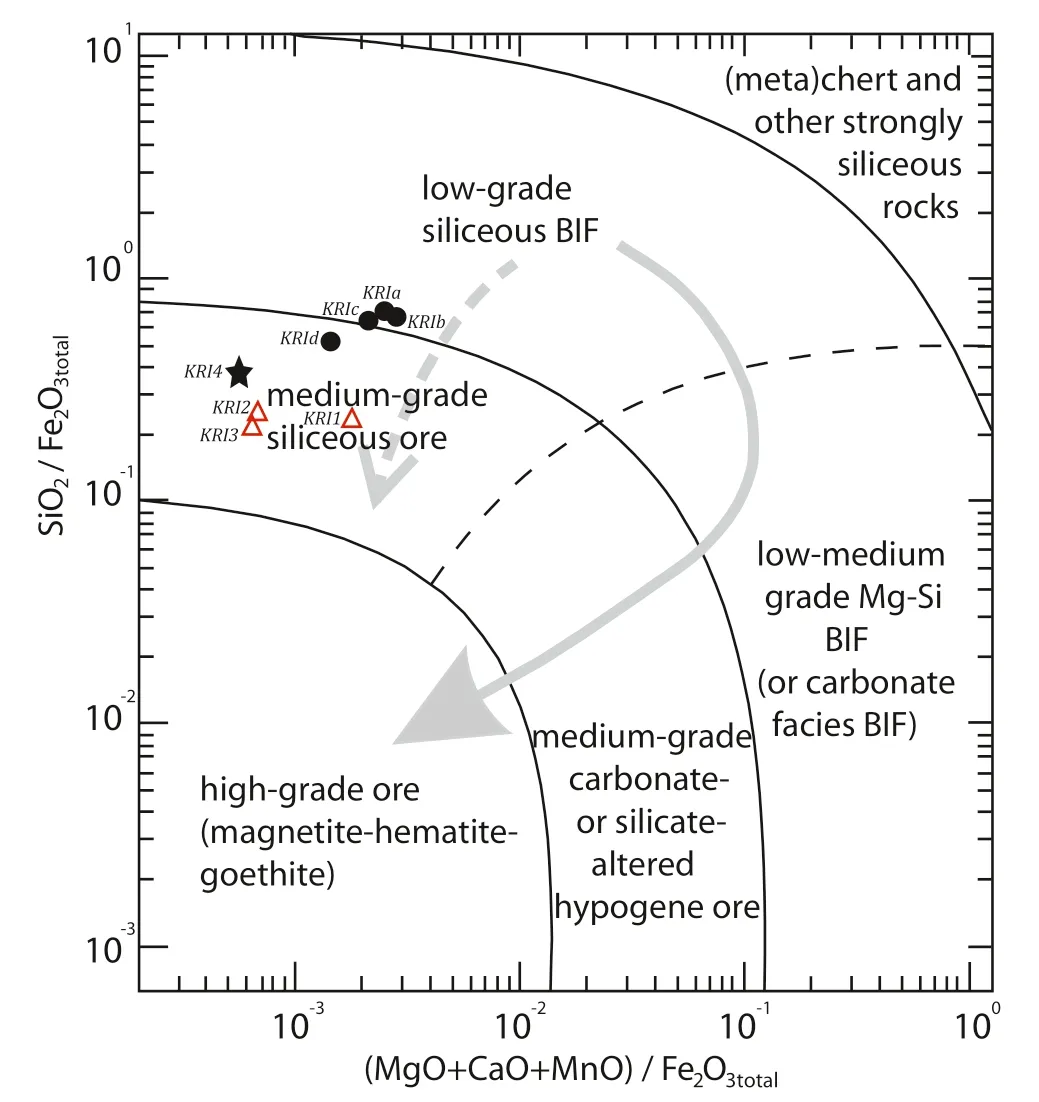
Fig.9 Whole-rock geochemistry plot(MgO+CaO+MnO)/Fe2-O3total versus SiO2/Fe2O3total(Angerer et al.2012)depicting the Mamelles iron ores as medium-grade siliceous ores
High-grade iron ore deposits have been widely interpreted to be products of chemical weathering(e.g.,Morris 1985;Ramanaidou 2009;Spier et al.2008).The weathering process is usually prevalent in humid tropical climates.The Mamelles deposit,situated in South Cameroon,was subject to warm humid tropical climatic conditions and therefore suffered a long period of lateritic weathering.In such an environment,meteoric waters dissolved and leached silica,while iron residually accumulated.This is chemically confirmed with SiOcontents decreasing from~26 wt% in saprock to~16 wt% in rock fragments whereas iron concentrations are higher in these iron ores(~72-76 wt% FeO)than in saprock(see Table 1).The weathering process is also characterized by higher AlOcontents in the uppermost iron ores(see Table 1)as is the case in supergene iron ores(Spier et al.2008;Ramanaidou 2009).
Trace and rare earth elements data also provide convincing evidence in favor of the supergene origin of the Mamelles iron ores.Indeed,pronounced enrichment of LILEs such as Sr and Ba commonly characterizes supergene iron ores(Gutzmer et al.2008).In the study area,iron ores are markedly enriched in Sr(2.8-11.4 ppm)and Ba(9.3-33.2 ppm)relative to the saprock(1 and 3.9 ppm,respectively),suggesting their supergene origin.In addition,REE patterns of the Mamelles iron ores display distinct LREE enrichment compared to the underlying saprock(see Fig.8),typical of iron ores of supergene origin(Gutzmer et al.2008).Accumulation of LREE in the weathering residue and mobilization of HREE in weathering mantles have been reported by several authors(e.g.,Braun et al.1990;Nelson et al.2003),as the result of preferential complexation and mobilization of HREE in low-temperature environments(Gutzmer et al.2008).
The Mamelles iron ore deposit is strategically located within an emerging regional iron ore corridor in South Cameroon that hosts several deposits such as Mbalam,Nkout,and Bikoula.The deposit is~35 km from the deep-water port currently under construction near Kribi and has the advantage of being the closest to the port of all the advanced iron ore projects in Cameroon.This strategic position to the port will considerably cut down exploitation costs such as transportation of the iron ore.Based on the above,the Mamelles deposit appears to be strategically well-situated,hosts medium-grade iron ores with acceptable contents in contaminants,and therefore needs to be investigated in more detail for its mining potential.
7 Conclusion
This study has documented the petrological and geochemical characteristics of BIF-hosted iron ores from the Mamelles deposit in SW Cameroon.Iron ores are composed of martite,goethite,quartz and lesser quantities of magnetite,hematite,kaolinite,and halloysite.They were derived from the supergene alteration of the underlying BIF.This study has shown that the Mamelles deposit contains medium-grade iron ores with acceptable contents in contaminants.Therefore,given its strategic location near the deep seaport,the deposit is believed to have a good mining potential and needs more detailed investigations.
Acknowledgements
The authors thank the editor and anonymous reviewers for their constructive comments which improved an earlier version of this paper.We also thank Remy Luechinger of ETH Zurich for the preparation of polished thin sections.Compliance with ethical standards
Conflict of interest
On behalf of all authors,the corresponding author states that there is no conflict of interest.- Acta Geochimica的其它文章
- Effect of crustal porosity on lunar magma ocean solidification
- Gold anomaly ranking based on stream sediment geochemistry in the Fariman-Kashmar axis,NE Iran
- Equilibrium mercury and lead isotope fractionation caused by nuclear volume effects in crystals
- Estimation of evaporation losses based on stable isotopes of stream water in a mountain watershed
- Geochemical significance of tricyclic and tetracyclic terpanes in source rock extracts from the Offshore Niger Delta Basin,Nigeria
- Paleoclimate evolution and aridification mechanism of the eastern Tethys during the Callovian-Oxfordian:evidence from geochemical records of the Qiangtang Basin,Tibetan Plateau

